 Over the years, you may have seen TFP members wearing the organization’s ceremonial habit at TFP or other events. Or you may have seen pictures of the TFP habit on the organization’s Web sites or publications.
Over the years, you may have seen TFP members wearing the organization’s ceremonial habit at TFP or other events. Or you may have seen pictures of the TFP habit on the organization’s Web sites or publications.
On January 22, 2009, for example, the estimated 300,000 participants of the 36th March for Life in Washington, D.C. saw four TFP members wearing the TFP ceremonial habit while carrying the International Pilgrim Virgin Statue of Our Lady of Fatima—the statue that wept miraculously in New Orleans in 1972.
Just as the Knights of Columbus have an official dress, with cape and naval chapeau, so also TFP members have a ceremonial habit and use it on special occasions.
If you ever wondered about the TFP habit’s origins and symbolism—with its scapular and hood, full-length Cross of Saint James, the large nickel-plated chain around the waist, the extra large Rosary hanging from the chain, a folded TFP cape hanging from the member’s left shoulder, the rampant lion adorning this red cape, the knee-length tunic and the knee-high boots—then you will enjoy reading this article for I was there, some 38 years ago, when the TFP habit came into existence.
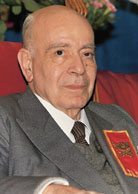
* * *
Like the lion-emblazoned, red and gold TFP standard and the hallmark red capes worn by TFP members in street campaigns, Professor Plinio Corrêa de Oliveira, the late founder of the Brazilian Society for the Defense of Tradition, Family, and Property created the TFP ceremonial habit.
In June 1970, at the initiative of Mr. Fábio Vidigal Xavier da Silveira, a director of the Brazilian TFP, the “Hermitage” of Elias was formed. It was the first of many “hermitages” to come. These are TFP centers that combined prayer and intellectual work in a reflective setting. The “hermitage” proved to be very popular with the Brazilian TFP members. It became popular with other TFPs, too, and the American TFP established a “hermitage” of its own some seven years later.
The Hermitage of Elias in São Paulo, Brazil, brought together a group of TFP members who wanted to study Church history, moral and dogmatic theology, and international affairs. The Brazilian TFP’s second hermitage was formed a month or so later in the countryside, some two hours away from São Paulo. In September 1970, I was one of four TFP members who formed the Brazilian TFP’s third hermitage, commonly known as the Hermitage of São Bento. The purpose of our hermitage was to help develop the TFP moral profile and human type.
Since we were Third Order Carmelites, we wore our Carmelite habit daily in the Hermitage of São Bento, as did Professor Corrêa de Oliveira when he came to visit and give meetings.
At some point in the Hermitage of São Bento’s first year, Professor Corrêa de Oliveira decided to create a habit for us, one that would express our TFP ideals better than the Third Order Carmelite habit we were wearing. This TFP habit would symbolize the total consecration to the Blessed Virgin Mary as a slave of love according to the method taught by Saint Louis de Montfort, the zeal and dedication of the military orders of chivalry, and the self-denial and piety of the monastic orders.
These Catholic models filled the hearts of TFP members with admiration and gave them enthusiasm for their own legal, peaceful and intellectual struggle against the ideological adversaries of the Church and Christian civilization. Thus, in a symbolic way, the TFP habit would express this three-faceted moral profile of a TFP member: slave, monk and warrior.
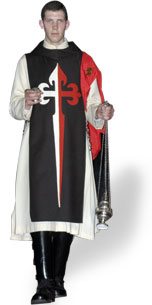
Professor Corrêa de Oliveira created the habit over the course of several visits to the Hermitage of São Bento, testing ideas, resolving problems and implementing improvements as the prototype was being developed. Developing a symbol is not always easy. In the case of the TFP habit, it took time and care.
In one of these sittings, TFP members and I watched Professor Corrêa de Oliveira draw the first sketch of the TFP’s Cross of Saint James that would later be made out of wool fabric and sewn onto the front of the large dark brown scapular.
Mr. Luiz Carlos Siqueira Campos, a TFP member with some artistic skill, made improved drawings of the TFP’s Cross of Saint James. Professor Corrêa de Oliveira reviewed and corrected each of Mr. Campos’ successive drawings until the final approved version used for the TFP habit.
This large pointed sword-cross of Saint James is red and white. The red half covers the TFP member’s left breast and the white half his right, while a golden thread runs down the middle. The red symbolizes a TFP member’s willingness to suffer martyrdom, if necessary, in defense of the Church and Christian civilization. The white symbolizes the purity of orthodoxy in the Faith and spotless chastity. The gold symbolizes the nobility of the TFP’s struggle.
When Blessed Pope Urban II convoked the First Crusade in 1095, he instructed those committing themselves to fight for the deliverance of the Holy Land from Muslim dominion to cut up strips of cloth, form a cross with them, and sew this cross onto their cloaks as a way of showing everyone that they had taken the Crusader’s vow. Although acting exclusively in the realm of ideas—always in a peaceful and legal way—the TFP’s struggle is a Crusade of sorts, and one as noble, motivated and selfless as that of Godfrey of Bouillon, the leader of the First Crusade. Professor Corrêa de Oliveira wanted to mark the TFP habit with a Crusader’s cross.
The TFP cross is so unusually large because a TFP member must be proud of the Cross of Our Lord Jesus Christ and embrace it with manly love, amidst a world where many are ashamed of the Cross, and many more hate and persecute it.
Professor Corrêa de Oliveira’s inspiration for the scapular’s hood came from the Benedictines and he arranged for Benedictine monks to be consulted on how they made their cowl. Professor Corrêa de Oliveira then made substantial changes. He gave the TFP hood a sharp and stiff point and stiffened the hood in general so that when folded, it does not crumple but remains firm, framing the TFP member’s head. It is somewhat evocative of a knight wearing a suit of armor, but without a helmet.
Drawing inspiration from a picture of Trappist monks working in a field, his first idea for the tunic was natural white, the color of undyed wool. However, when he saw the greater effect caused by the brown scapular over the Third Order Carmelites’ brown tunic, he opted for dark brown.
Professor Corrêa de Oliveira liked the length of the tunics worn by medieval Russian czars and adopted it in the TFP habit. Thus, the TFP tunic is not ankle-length, but raised so that the boots can be seen. This particular length helps give the TFP member a medieval, Crusader-like look.
Because of the tunic’s length, the black boots needed to be tall. He started off with the boots worn by the Brazilian cavalry. He wanted a soft leather covering for the leg’s calf, but when this proved impractical, he opted for stiff leather, gradually extending the coverings to just below the knee. Brazilian cavalry boots had three buckles around the calf. Professor Corrêa de Oliveira made it four. In opposition to a world enslaved to fashion, he did not want boots that were elegant.
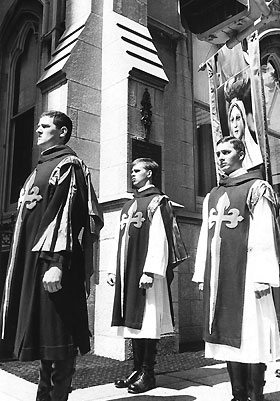
As for the chain on the TFP habit, to my knowledge Professor Corrêa de Oliveira was the first person in history to use a large-link chain as a cincture in the official attire of a group of people. Over the centuries, many saints and pious people have worn chains privately to express physically their spiritual slavery of love to the Blessed Virgin Mary. However, Professor Corrêa de Oliveira wanted TFP members to do this openly and unapologetically, as an exterior act of devotion to the Blessed Mother and her Divine Son and a rebuke to a world that has largely abandoned Them.
Many wear chains today, influenced by punk or Gothic trends. Some may even wear it around their waist. One can only wonder what their chains symbolize: Is it slavery to unbridled passion?
Having put on the chain, a TFP member lets either three or seven chain links hang down on his left side. Three links honor Our Lady as daughter, mother and spouse of God. Seven links honor her Seven Sorrows or Seven Joys.
The Rosary had to be large as well to express the importance a TFP member gave to its daily recitation and as a constant reminder of Our Lady of Fatima’s call to conversion and request that it be prayed.
Black boots, dark brown tunic, dark brown scapular with pointed hood and large Cross of Saint James, large-link chain girding the waist and large Rosary—the TFP founder had created the organization’s ceremonial habit.
Nuns from Campos, Rio de Janeiro, very close friends of the Brazilian TFP, sewed the first TFP habits.
On September 9, 1971, the Hermitage of São Bento’s first anniversary, Professor Plinio Corrêa de Oliveira bestowed the new TFP habits on the members of the hermitage as well as on other veteran TFP members.
* * *
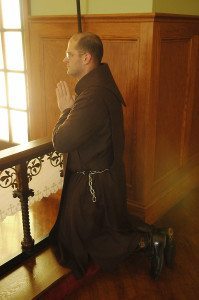 Use of the TFP habit quickly spread to numerous members of the Brazilian TFP as well as foreign TFPs.
Use of the TFP habit quickly spread to numerous members of the Brazilian TFP as well as foreign TFPs.
In 1974, at Professor Corrêa de Oliveira’s request, a TFP member consulted Reverend Fathers Arturo Alonso Lobo, O.P. and Sabino Alonso Moran, O.P.—two world-renowned canonists in Salamanca, Spain—if the private and public use of the TFP habit by members of the Brazilian TFP, a civic organization of lay Catholics, violated Canon Law in any way because of the similarities between the TFP habit and habits of specific religious orders. The eminent canon lawyers wrote that it was perfectly legitimate for the TFP to desire to have and to wear a habit of its own, and that the TFP habit could be worn publicly and privately without violating Canon Law or Church norms.
A few years latter, Professor Corrêa de Oliveira developed a tunic for younger TFP members by returning to his 1971 idea, making it natural white, the color of undyed wool.
Given the glorious use of the TFP’s red cape in untold street campaigns, Professor Corrêa de Oliveira decided to incorporate it to the habit as well. He did this by having the cape folded and sewn onto the left shoulder of the dark brown scapular. The TFP’s gold rampant lion was pinned to it, shining from amid the crimson background. I was fortunate to be there when Professor Corrêa de Oliveira did this and served as the model, while TFP member Umberto Braccesi folded the cape and held it in place with sewing pins for Professor Corrêa de Oliveira to see and correct.
* * *
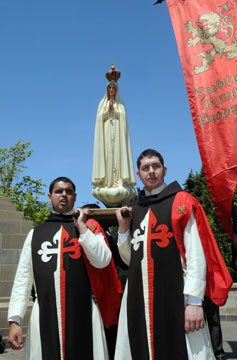
On August 26, 1978, the TFP ceremonial habit was worn on Fifth Avenue in New York City for the first time. The American TFP marched up twenty-five blocks on Fifth Avenue, starting at Madison Square Park and ending on the steps of Saint Patrick’s Cathedral. The purpose of this public act was to beseech God to send a strong and holy pope to the Church, a new Saint Pius X.
Almost thirty-one years later, on May 17, 2009, four TFP members wore the organization’s ceremonial habit while carrying a statue of Our Lady of Fatima as part of the 4,000-strong protest outside the University of Notre Dame. The TFP was offering public reparation for this institution’s scandalous decision to invite and to honor our nation’s president—a pro-abortion politician.
Between these first and the latest uses of the TFP habit in the United States, millions of Americans have wondered about its history and symbolism. If you were among them, you no longer have to wonder, for now you know.
